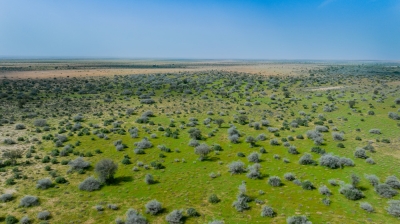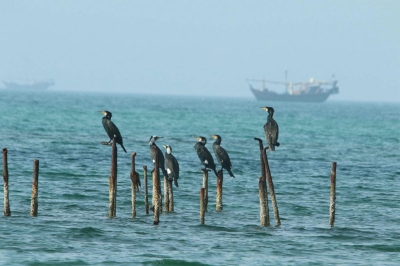
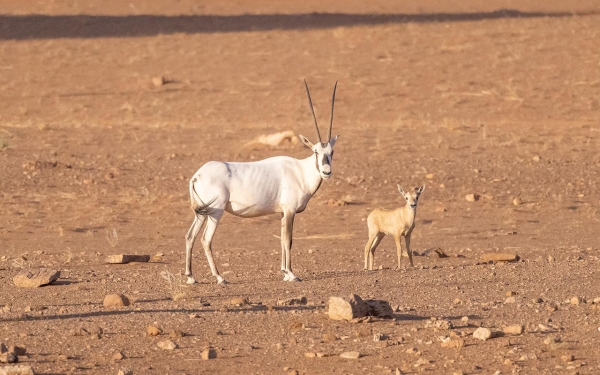
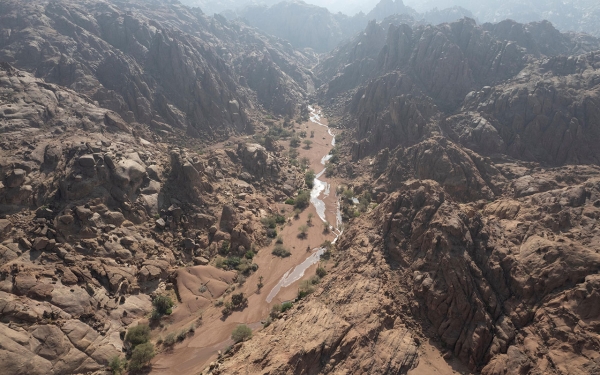
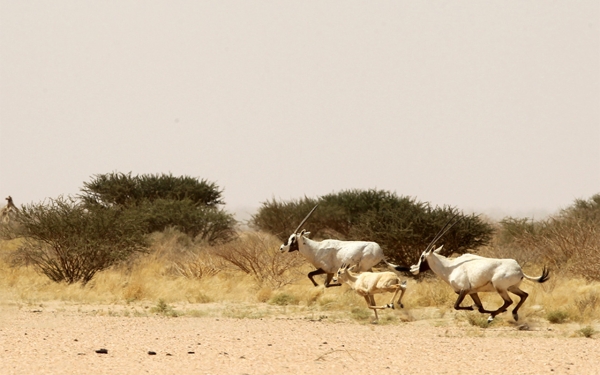
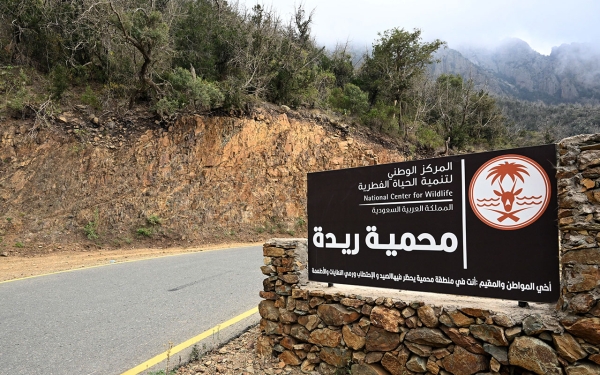
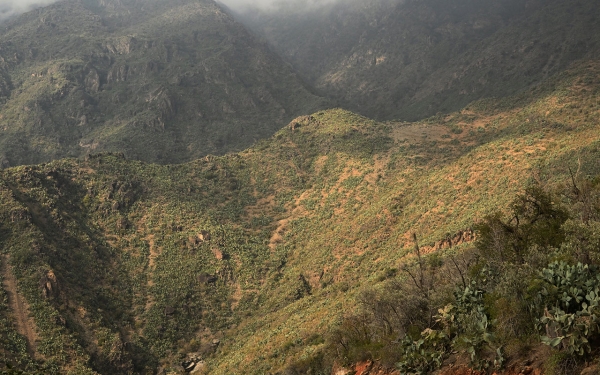
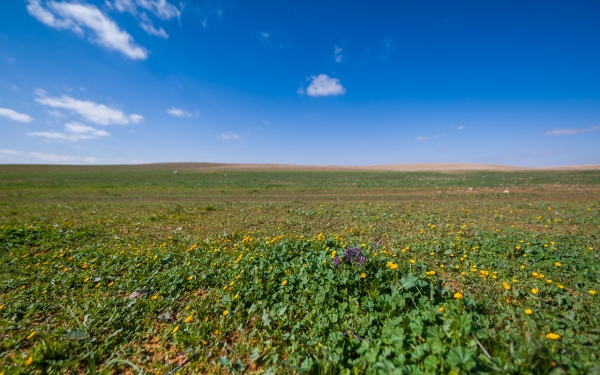
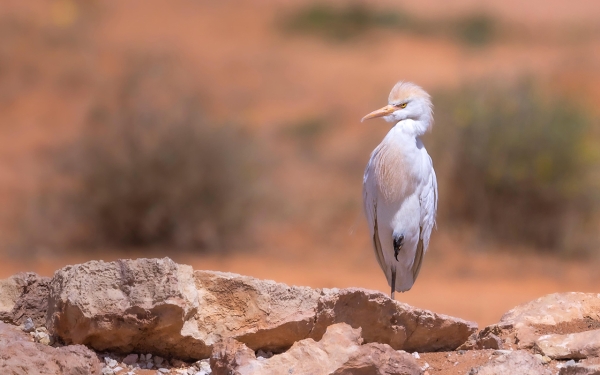

The Nature Reserves in the Kingdom of Saudi Arabia are designated geographical areas aimed at preserving natural habitats and biodiversity and protecting a range of integrated natural ecosystems. These areas are managed through specific mechanisms and entities.
Area of all nature reserves in Saudi Arabia
The total area of all nature reserves in the Kingdom is estimated to be around 16.86 percent of the Kingdom's total area.
History of wildlife protection in Saudi Arabia
In 1991, a document titled "National System for Wildlife Conservation and Sustainable Rural Development in the Kingdom" was prepared.
In 2015, the Wildlife Protected Areas Law was issued in the Kingdom, followed by the Environmental Law in 2020, which includes protected wildlife areas within its jurisdiction.
The protected areas system, which continues to be updated based on environmental developments, proposes the protection of seventy-five areas, including sixty-two terrestrial areas and thirteen coastal and marine areas.
The National Center for Wildlife Development, established in 2019, is the entity responsible for the conservation of wildlife and biodiversity in the Kingdom, in addition to its role in protecting and managing protected areas, both terrestrial and coastal/marine, excluding royal reserves. This includes the protection and development of wildlife, both terrestrial and marine, and efforts to reintroduce endangered species to their natural habitats.
The Royal Reserves Council, established by Royal Decree in 2018, is one of the entities responsible for the protection and development of the royal nature reserves in the Kingdom by preserving the environmental and natural components of these reserves, reintroducing wildlife, enhancing conservation efforts, and promoting eco-tourism. The council operates as one of the departments under the Royal Court.
The number of nature reserves in Saudi Arabia
The number of nature reserves in the Kingdom reaches approximately twenty-three, including eight Royal reserves, each headed by an independent board of directors, ten nature reserves managed by the National Center for Wildlife Development, and five reserves under the Royal Commission for al-Ula.
These nature reserves are managed by an administrative and technical team, which includes a director for each reserve and a team of rangers responsible for ground monitoring, with the task of observing wildlife within the reserve and preventing violations.
The first reserve in Saudi Arabia
Harrat al-Harrah Reserve is considered the first reserve in the Kingdom. It was officially declared a reserve in 1987, with an area of 13,775 km², later incorporated into King Salman Bin Abdulaziz Royal Reserve. Located northwest of the Kingdom, it extends east of Wadi as-Sirhan. The surface of Harrat al-Harrah Reserve consists of a volcanic plateau with numerous black basalt rocks, along with low volcanic mountains ranging in height from eight hundred to 1,150 m above sea level.
The reserve is distinguished by the diversity of its vegetation, which includes both perennial and annual plants, often thriving in floodplain areas. Among the trees found in the reserve are Tamarix, Tamarix Aucheriana, Lycium (Lycium shawii), and fire bush (Calligonum comosum). Additionally, there are numerous shrubs and annual herbs throughout the area.
The reserve is home to a variety of animals, including the Cape hare (Lepus capensis), Arabian wolf (Canis lupus arabs), Arabian sand gazelle (Gazella marica), red fox (Vulpes vulpes), sand fox (Vulpes rueppellii), striped hyena (Hyaena hyaena), jerboa, and several species of reptiles. Additionally, the reserve hosts birds such as the houbara bustard (Chlamydotis undulata), stone curlew (Burhinidae), golden eagle (Aquila chrysaetos), and around nine species of larks, along with other resident and migratory birds.
The first model national reserve in Saudi Arabia
Uruq Bani Ma’arid Reserve is one of the nature reserves in the Kingdom and was selected by the National Center for Wildlife Development to be the first model reserve in the Kingdom. It is pioneering the use of modern technologies, such as drones for monitoring, conducting surveys, and environmental studies. The reserve also utilizes renewable energy, implements environmental sanitation controls, develops eco-tourism programs, involves the local community, and adopts an advanced management plan for the reserve.
On March 10, 2021, the rehabilitation projects for Uruq Bani Ma’arid Reserve were launched, marking it as the first model national reserve in the Kingdom. As part of the National Program for the Release and Reintroduction of Endangered Wildlife, several species were released into the reserve and national parks across the Kingdom. The launch included seven projects, which comprised: the Natural World Heritage and Green Areas Programs, the Protection and Monitoring Program utilizing modern technology, the Program for Redefining Protection Zones, the development of a detailed Environmental Sanitation Plan, mechanisms for Scientific Research and Monitoring directed towards wildlife protection, the Local Participation, Environmental Awareness, and Education Program, and the Sustainable Grazing Plan Program.
The registration of Uruq Bani Ma’arid Reserve on the UNESCO World Heritage List
On September 20, 2023, it was announced that Uruq Bani Ma’arid Reserve had been registered on the UNESCO World Heritage List as the first natural World Heritage site in the Kingdom. This achievement is part of the Kingdom's ongoing efforts to protect and preserve its natural ecosystems and its commitment to safeguarding its cultural heritage. The decision to register the site was made during the forty-fifth annual session of the World Heritage Committee, which was hosted in Riyadh from September 10 to 25, 2023.
The reserve is located on the southwestern edge of ar-Rub' al-Khali (Empty Quarter) desert, approximately 396 km by car north of Najran City. It features several significant landforms and natural wildlife habitats, including high sand dunes and a fragmented limestone plateau. It is the only reserve located in Najran Province.
Uruq Bani Ma’arid Reserve was established in 1993 and is the largest reserve overseen by the National Center for Wildlife in terms of area, covering approximately 12,787 km². The protection within the reserve is divided into two levels: one for wildlife and the other for the environment and trees.
The overall environmental condition of the reserve is classified as good, with its plant and animal wildlife representative of arid environments. The most common plants in the reserve include Haloxylon (Haloxylon persicum), Panicum (panicgrass), Acacia trees (Acacia spp.), Moringa (Moringa peregrina), Peganum (Peganum harmala), Tamarisk, and Calotropis (Calotropis procera).
As for the wildlife in Uruq Bani Ma’arid Reserve, it includes the Arabian wolf, sand cat (Felis margarita), sand fox, striped hyena, rock hyrax (Procavia capensis), and Cape hare. Among the birds are the houbara bustard, sandgrouse (Pterocles spp.), partridge (Alectoris spp.), grey shrike (Lanius excubitor), Egyptian vulture (Neophron percnopterus), and several species of larks. The reserve is also home to various reptiles, including the spiny-tailed lizard (Uromastyx spp.) and monitor lizards (Varanus spp.).
Uruq Bani Ma’arid Reserve was the last habitat in the Arabian Peninsula where the Arabian oryx was sighted in 1979. The Arabian ostrich, Arabian sand gazelle, Arabian gazelle, and Nubian ibex also used to inhabit the reserve in the past. In 1995 and 1996, a reintroduction program for the Arabian oryx, Arabian sand gazelle, and mountain gazelle was implemented in the reserve. Over time, these animals adapted and naturally reproduced in the reserve’s environment.
Sharaan Nature Reserve in al-Ula Governorate
Sharaan Nature Reserve in al-Ula Governorate, located in al-Madinah al-Munawwarah Province in the western parts of the Kingdom, is the first protected area under the Royal Commission for al-Ula. The reserve adheres to specific commitments in line with global standards to provide suitable wildlife habitats, protect the natural ecosystems in the province, and preserve its natural elements.
In 2019, His Royal Highness Prince Mohammed Bin Salman Bin Abdulaziz Al Saud, crown prince, prime minister, and chairman of the Board of Directors of the Royal Commission for al-Ula, launched Sharaan Nature Reserve as a protected area under the management of the commission.
Sharaan Nature Reserve is located within the eastern valley of al-Ula. It is naturally created as a reserve, featuring red rock canyons, wide sloping valleys, dense sand formations, and desert areas with rocky plateaus.
The reserve is home to native plant species, including Acacia, grasses (Poaceae spp.), saltwort (Haloxylon salicornicum), and broom bush (Retama raetam). It also hosts rare aromatic plants such as Artemisia (Artemisia herba-alba). The reserve is inhabited by local wildlife such as the Arabian leopard, Nubian ibex, ostrich, gazelles, Arabian wolf, and red fox. It also serves as a refuge for other animals like the rock hyrax, desert hare, laughing dove, and larks. Additionally, it is home to a variety of birds of prey, including eagles, lappet-faced vultures, and long-legged buzzards.
Sharaan Nature Reserve falls under the responsibilities of the Global Fund for the Arabian Leopard, a species of leopard that is critically endangered. Studies indicate that only around two hundred Arabian leopards remain, living in scattered habitats across the Arab world, including this reserve.
The Royal Commission for al-Ula oversees approximately five reserves: Sharaan Reserve, al-Gharameel Reserve, Harrat al-Zabn Reserve, Harrat 'Uwayrid Reserve, and Wadi al-Nakhla Reserve.
The wildlife reserves in Saudi Arabia
Ibex Reserve
Ibex Nature Reserve is located south of al-Hariq Governorate and west of Hotat Bani Tamim Governorate, approximately 180 km from Riyadh. It is a large, rugged plateau within at-Tuwaiq Mountain range, featuring several valleys, ravines, and some sandy areas. The western edges of the mountains reach an elevation of 1,097 m. It is one of three reserves in Riyadh Province.
The reserve was established in 1988, the same year the Umm al-Qamari Island and Mahazat as-Sayd reserves were announced.
The Ibex Reserve covers an area of 1,840.9 km², and its protection is divided into two levels: the first for terrestrial wildlife, and the second for the environment, trees, and forests.
The primary reason for establishing the reserve was the decline in the number of ibex herds at that time, which soon increased after protection measures were implemented. Other animals living in the reserve include a large number of rock hyrax (Procavia capensis), foxes, several species of rodents, and birds, the most notable of which is the sand partridge (Ammoperdix heyi). The reserve also hosts a variety of reptiles. In 1990, a reintroduction program for the mountain gazelle was carried out in the reserve, where they adapted well to the region and their number has since grown.
In the Ibex Reserve, Acacia trees, Arabian gum trees (Acacia tortilis), Selim trees (Acacia ehrenbergiana), jujube trees (Ziziphus spina-christi), and Haloxylon (Haloxylon persicum), are abundant, particularly in its valleys. Shrubs, herbs, and grasses also spread across the small valleys and ravines, growing well after rainfall.
Jabal Shada al-A'la Nature Reserve
Jabal Shada al-A'la Reserve, one of the nature reserves in the Kingdom, is located northwest of al-Mikhwah Governorate, approximately twenty km away. It is the only reserve in al-Bahah Province.
The reserve was established in 2001 and is the second smallest reserve overseen by the National Center for Wildlife, covering an area of approximately 68.62 km². The protection within the reserve is divided into two levels: the first for wildlife, and the second for the environment and trees.
Jabal Shada al-A'la is an extension of the Sarawat Mountains to the west, running nearly parallel to them. It was formed as a result of the uplift movement of the Arabian Shield millions of years ago, making it a transitional area between the Red Sea Rift and the Sarawat Highlands.
Jabal Shada al-A'la rises approximately 2,200 m above sea level, and its highlands are composed of basaltic rocks, from which valleys slope downwards.
The reserve is home to various trees, including juniper and wild olive, as well as several shrubs, herbs, and grasses. The key wildlife species found in the reserve include the Arabian leopard, striped hyena, Arabian wolf, foxes, and caracal.
Jurf Raydah Nature Reserve
Jurf Raydah Nature Reserve is located in the southwest of the Kingdom, within the Sarawat Mountains. It is the only reserve in Aseer Province and is situated approximately twenty km northwest of Abha City.
The reserve was established in 1989, the same year the Farasan Islands and at-Tubayq reserves were announced. It is the smallest of the nature reserves overseen by the National Center for Wildlife, with an area of approximately 9.33 km². The protection within the reserve is divided into two levels: the first for terrestrial wildlife, and the second for the environment and trees.
The reserve is characterized by the density and diversity of its vegetation cover, with juniper forests spreading across the upper cliff, followed by wild olive (Olea europaea) and acacia trees (Acacia spp.) at lower levels, along with several types of cacti. The reserve's valleys are notable for their high level of plant diversity and dense vegetation cover.
Jurf Raydah is considered part of the Arabian Shield, primarily composed of igneous rocks that are tectonically active. The reserve is comprised of steep slopes covered by dense vegetation, predominantly juniper trees, with a number of water tributaries descending from the top of the cliff and pouring into Raydah Valley.
Nufud al-ʽUrayq Nature Reserve
It is one of the nature reserves in the Kingdom, located in the central region, southwest of Buraydah Governorate. This reserve is the only one in Qassim Province and is approximately two hundred km away from Buraydah Governorate, the administrative capital of the province.
The reserve was established in 1994, the same year at-Taysiyah, Saja, and Umm ar-Rimth reserves were announced. It covers an area of approximately 2,036.1 km². The protection within the reserve is divided into two levels: the first for terrestrial wildlife, and the second for the environment and trees.
Nafud al-ʽUrayq Nature Reserve has a vegetation cover that encourages the reintroduction of some birds, and its ecosystems are characterized by gravel sandy plains and some granitic and basaltic mountains. The area has long been considered a protected zone for Ibl al-Sadaqa, due to its vegetation cover, which includes Lycium, fire bush, and various annual plants.
The Saja and Umm ar-Rimth Nature Reserve
Saja and Umm ar-Rimth Reserve is located northwest of Mahazat as-Sayd Reserve, approximately 265 km from Taif Governorate. It is one of four reserves situated in Makkah al-Mukarramah Province.
Saja and Umm ar-Rimth Reserve has moderate vegetation cover that helps preserve the genetic resources of some endemic and rare mammals, birds, and reptiles in the area.
The reserve was established in 1994, the same year that at-Taysiyah Reserve and Nafud al-'Urayq Reserve were announced. The environments of the reserve vary between gently undulating low hills, exposed gravel plains, and valleys dominated by desert grass, Acacia trees, Arabian gum trees, colocynth (Citrullus colocynthis), and Peganum (Peganum harmala).
Saja and Umm ar-Rimth Reserve is the second largest reserve overseen by the National Center for Wildlife, after Uruq Bani Ma’arid Reserve, covering an area of approximately 6,528.2 km². The protection within the reserve is divided into two levels: the first for terrestrial wildlife, and the second for the environment and trees.
In the period following the establishment of the reserve, a limited number of houbara bustards were released as part of the natural extension of the species' range between Mahazat as-Sayd Reserve and other breeding grounds.
Majami' al-Hadb Nature Reserve
It is one of the nature reserves in the Kingdom, located approximately 125 km northeast of Ranyah Governorate. It is one of four reserves in Makkah al-Mukarramah Province.
The reserve was established in 1992 and is overseen by the National Center for Wildlife. It covers an area of approximately 2,256.4 km². The reserve’s protection is divided into two levels: the first for marine wildlife and the second for the environment and trees.
The reserve features numerous exfoliated granite domes with pale colors, dark volcanic mountains, and sandy desert plains. A total of forty-eight plant species have been recorded, with prominent groups including Arabian gum trees, Acacia trees, jujube trees, Moringa, and Salvadora (Salvadora persica). The National Center for Wildlife is working on reintroducing some wildlife species that have disappeared from the reserve.
The marine reserves in Saudi Arabia
Farasan Islands Nature Reserve
It is one of the nature reserves in the Kingdom, located in the southeastern part of the Red Sea, about forty-two km off the coast of Jazan City. The reserve includes approximately eighty-four islands, the largest of which are Farasan al-Kabir Island, Saqid (Farasan as-Sughra), and Qummah. These islands are inhabited, with most of the population engaged in fishing and the cultivation of millet and corn. It is the only reserve located in Jazan Province.
The reserve was established in 1989, the same year that at-Tubaiq and Jurf Raydah reserves were announced.
Farasan Islands Reserve is the third largest reserve overseen by the National Center for Wildlife in terms of area, after Uruq Bani Ma'arid Reserve and Saja and Umm ar-Rimth Reserve, covering an area of approximately 5,408 km². Its protection is divided into two levels: the first for terrestrial and marine wildlife, and the second for the environment and trees.
The reserve consists of coral limestone plateaus with an average elevation of ten to twenty m above sea level, though in some areas it can reach up to forty m. The highest elevation of these plateaus is seventy-five m, locally referred to as "mountains." The reserve also has several short valleys that flow into the sea. Its coasts are covered with white calcareous sand, formed from the breakdown of coral reefs and seashells.
Among the types of trees in the Farasan Islands Reserve are Arabian gum trees, balsam trees (Commiphora spp.), jujube trees (Ziziphus spina-christi), and toothbrush trees (Salvadora persica), in addition to mangrove trees (Avicennia marina) and grey mangroves (Rhizophora mucronata), which form dense coastal thickets. In recent years, the invasive mesquite tree (Prosopis spp.) has also spread in the area.
The reserve is home to the endemic Farasan gazelle, which inhabits some of its islands, as well as the white-tailed mongoose and several species of rodents.
The reserve hosts a variety of birds, particularly waterbirds, shorebirds, and migratory species, including the osprey, grey pelican, sooty gull, herons, and the red-necked falcon. Additionally, it is home to several species of turtle doves, and various lizards and snakes.
In terms of eco-tourism, the reserve offers around six tourism packages for visiting, including: Farasan Camp, Underwater World, Discover Natural Plants in Farasan, The Fisherman, Nature’s Mural, and Farasan Islands... The Enchanting Coral Jewels.
Umm al-Qamari Island Reserve
Umm al-Qamari Island Reserve is located southwest of al-Qunfudhah Governorate in the Red Sea. It is one of four reserves situated in Makkah al-Mukarramah Province.
The reserve was established in 1988, the same year that Mahazat as-Sayd and Ibex reserves were announced. It is the third smallest reserve overseen by the National Center for Wildlife, covering an area of approximately 4.03 km². The protection in the reserve is divided into two levels: the first for terrestrial and marine wildlife, and the second for the environment and trees.
The reserve consists of two islands: Umm al-Qamari al-Barraniyah and Umm al-Qamari al-Fawqaniyah. It is named "Umm al-Qamari" due to the abundance of turtle doves, especially during the migration season. The reserve is also home to various species of seabirds, shorebirds, and terrestrial birds, including the osprey, herons, the great egret, and the African collared dove.
Many of the coral reefs around Umm al-Qamari al-Barraniyah Island are alive and diverse, making them ideal for study. The marine life in the area is rich with various coral reefs and marine invertebrates. Vegetation is abundant in the middle of the two islands, including plants such as toothbrush tree, Suaeda (Suaeda spp.), cacti, thorn plants (Tribulus spp.), and saltbush (Atriplex spp.), which are also common along the coasts.
The surface of the two islands consists of coral limestone rocks with an average elevation of three m above sea level, along with white coastal sands.
Al-Jubayl Marine Wildlife Reserve
It is one of the nature reserves in the Kingdom, located north of Jubail Industrial City along the western coast of the Arabian Gulf, stretching from Abu Ali Island in the south to Ras al-Zour in the north. The reserve includes five coral islands, encompassing Dawhat ad-Dafi, Dawhat al-Musallamiyah, and the islands located in that region. It is the only reserve located in the Eastern Province.
Al-Jubayl Marine Wildlife Reserve is the fourth largest reserve overseen by the National Center for Wildlife in terms of area, following Uruq Bani Ma’arid Reserve, Saja and Umm ar-Rimth Reserve, and Farasan Islands Reserve. It covers an area of 2,410.69 km². The protection in the reserve is divided into two levels: the first for terrestrial and marine wildlife, and the second for the environment and trees.
The reserve features diverse environments and a wide range of wildlife. In its terrestrial environment, there are red foxes, jackals, and several species of rodents, along with various birds, including two species of larks. The reserve also hosts different species of lizards and snakes. In its coastal environment, the reserve is home to flamingos, various species of sandpipers, gulls, terns, ducks, herons, and the Socotra cormorant. In its nearshore aquatic environment, there are numerous invertebrates, such as snails and crabs.
The reserve was established due to oil pollution in the coastal areas along the shores of the Arabian Gulf following the Gulf War in 1990. Several environmental studies and research projects were conducted, which recommended the establishment of al-Jubayl Marine Wildlife Reserve to monitor pollution and its effects, aiming to preserve the marine biodiversity that characterizes the region.
Royal reserves in Saudi Arabia
King Salman Bin Abdulaziz Royal Nature Reserve
In 2018, a Royal Decree was issued to convert Harrat al-Harrah, al-Khunfah, and at-Tubaiq reserves, along with the areas between and adjacent to them, into a Royal reserve named "King Salman Bin Abdulaziz Royal Reserve." Covering an area of approximately 130,700 km², it is the largest royal and nature reserve in the Kingdom. The reserve is overseen by the Royal Reserves Council, chaired by Crown Prince and Prime Minister, Prince Mohammed Bin Salman Bin Abdulaziz Al Saud.
The reserve's boundaries overlap with several governorates and villages, including al-Qurayyat and Tabarjal in al-Jawf Province, and Turayf in the Northern Borders Province. The reserve is bordered by Tabuk Province to the west, Tayma to the southwest, Hail to the southeast, and Sikaka and Dawmat al-Jandal to the east. To the north, it is near the Saudi-Jordanian border, close to Wadi Rum.
The reserve is rich in animal diversity, with approximately 282 species, including mammals, birds, reptiles, and amphibians. Among the animals found in the reserve are the Arabian sand gazelle, Arabian wolf, Arabian fox, Nubian ibex, Cape hare, houbara bustard, golden eagle, stone curlew, red fox, gray wolf, sand cat, desert hedgehog, Egyptian fruit bat, and saker falcon.
Imam Turki Bin Abdullah Royal Reserve
Imam Turki Bin Abdullah Reserve is located northeast of Riyadh Province, extending to the eastern side of Hail City. In 2018, a Royal Decree was issued to convert at-Taysiyyah Reserve and the surrounding areas into a royal reserve under the name "Imam Turki Bin Abdullah Royal Reserve."
The reserve spans an area of approximately 91,500 km², making it the second largest royal reserve after King Salman Bin Abdulaziz Royal Reserve. It is overseen by the Royal Reserves Council and has a designated chairman and board of directors.
Imam Turki Bin Abdullah Reserve has a good vegetation cover, with around fifty species, including trees such as Acacia and jujube, as well as shrubs like Lycium, Arfaj (Rhanterium epapposum), and saltwort (Haloxylon salicornicum). The houbara bustard is found in the reserve, though it is rare. Efforts to reintroduce the houbara bustard and other endangered wildlife in this area are enhancing the reserve's role as a natural extension of the movement routes of these species beyond the reserve's borders.
Imam Saud Bin Abdulaziz Royal Reserve
It is one of the royal reserves in the Kingdom, located northeast of Taif Governorate in Makkah al-Mukarramah Province. In 2018, a Royal Decree was issued to convert Mahazat as-Sayd Reserve into a royal reserve under the name "Imam Saud Bin Abdulaziz Royal Reserve." It is located 180 km away from Taif Governorate.
The reserve was enclosed by a fence with a perimeter of 220 km to serve as a natural laboratory for the reintroduction of native wildlife species. The fence helped protect the vegetation, which was on the verge of extinction, allowing the reserve to become rich with annual and seasonal plants and grasses. The protection in the reserve is divided into two levels: the first for terrestrial wildlife, and the second for the environment and trees.
The vegetation in the reserve includes short grasses interspersed with scattered groups of Arabian gum trees, Salvadora trees, and Pulicaria shrubs. In addition, the reserve hosts other desert plants such as saltwort, Lycium, and desert grass.
The animals that inhabit the reserve include the Arabian wolf, sand fox, sand cat, and several species of rodents. Additionally, the reserve is home to birds such as the bald eagle, griffon vulture, Egyptian vulture, and various species of reptiles.
In 1990, the reintroduction program released seventeen Arabian oryx into the reserve, followed by several small groups at subsequent intervals. Arabian sand gazelle and houbara bustard were also reintroduced into the reserve between 1990 and 1991. Additionally, the red-necked ostrich, the closest living relative to the extinct Arabian ostrich, was introduced. These species have since increased in numbers under protection.
Imam Abdulaziz Bin Mohammed Royal Reserve
Imam Abdulaziz Bin Mohammed Reserve is located in the northeastern part of Riyadh Province, about 114 km from the capital, Riyadh. In 2018, a Royal Decree was issued to convert Rawdat Khuraim and the surrounding areas into a royal reserve under the name "Imam Abdulaziz Bin Mohammed Royal Reserve."
The reserve covers an area of approximately 11,300 km², making it the second smallest royal reserve after Imam Saud Bin Abdulaziz Royal Reserve. It is overseen by the Royal Reserves Council, with a designated chairman and board of directors.
The protection in the Imam Abdulaziz Bin Mohammed Reserve is divided into two levels: the first for wild animals, and the second for the environment and trees. Rawdat Khuraim, which was incorporated into Imam Abdulaziz Bin Mohammed Royal Reserve, is known for its green landscape and water pathways, with several seasonal streams flowing into it.
King Khalid Royal Reserve
Previously known as ath-Thumamah Park, it is located northeast of Riyadh, specifically to the southeast of King Khalid International Airport. In 2019, approval was granted to convert the park into a royal reserve.
The reserve covers an area of approximately 1,162 km². It is overseen by the Royal Reserves Council, with a designated chairman and board of directors.
King Khalid Reserve is accessible via a network of dual roads from four different directions. It is located about ninety-three km from the center of Riyadh and approximately sixty-one km from King Khalid International Airport. The reserve consists of plateaus interspersed with canyons and valleys, as well as plains with varying elevations.
The reserve boasts a rich diversity of plant and animal life, with approximately 195 species of plants, four species of mammals, 148 species of birds, twenty-one species of reptiles, and eight insect orders.
The reserve features a natural museum located at the base of al-'Armah Mountains, offering exhibits on geology, ancient artifacts, and various natural formations. The museum covers an area of about 2,100 m². Within the reserve, there are cable cars (telefriques) running from the botanical garden station to the top of al-'Armah Mountains, reaching Khashm ath-Thumamah to the south, then crossing Ria' ath-Thumamah to reach Khashm ath-Thumamah to the north, before descending to the natural museum station.
One of the reserve’s highlights is the safari park, an open area hosting animals from different environments, covering an area of approximately twenty million m². The reserve also includes the Safari Chalets, a set of twenty chalets designed like cabins, located on a hill beside the safari park, covering an area of three thousand m².
The reserve also includes a botanical garden, desert camps, daily family camps, an adventure center, and a recreational sports center for youth, youth camps, a visitor center, and the Saudi Aviation Club. It is also home to the King Khalid Wildlife Research Center, which covers an area of about seven million m². The center features offices, laboratories, a visitor center, animal breeding facilities, and a large fenced area.
The reserve is distinguished by a mix of sand dunes and numerous natural tributaries feeding into Wadi as-Sulay, which run alongside these sand dunes, such as Abu Shajarah Valley.
King Abdulaziz Royal Reserve
King Abdulaziz Royal Reserve is located north of Riyadh Province, about 180 km from the capital. In 2018, a Royal Decree was issued to convert at-Tanahat and al-Khafs reserves, along with the surrounding areas, into a royal reserve under the name "King Abdulaziz Royal Reserve."
The reserve covers an area of approximately 15,700 km² and is overseen by the Royal Reserves Council, with a designated chairman and board of directors.
After the inclusion of Rawdat at-Tanhat, King Abdulaziz Reserve has become a popular tourist destination, attracting visitors from various nationalities. It has been mentioned in numerous classical and contemporary Arabic poems and served as a recreational area for the Kingdom's founder, King Abdulaziz, and his sons after him.
Prince Mohammed Bin Salman Royal Reserve
It encompasses the area between the Neom Project, the Red Sea Project, and al-Ula. It was established by Royal Decree in 2018.
The reserve spans approximately sixteen thousand km² and is overseen by the Royal Reserves Council, with a board of directors chaired by Prince Mohammed Bin Salman.
The reserve extends along the northwestern coast from Duba Governorate in the north to al-Wajh Governorate in the south. Several centers are located in the eastern parts of the reserve, including Badaa, Abu Rakah, Wadi ad-Disah, Ruhayb, and ad-Dhulfah.
The reserve’s location is strategic, positioned among several large-scale tourism and development projects announced by the Kingdom, such as the Neom Project, Amaala Project, and the Wadi ad-Disa Development Project. It is also near the historic al-Ula City, known for its rich history and multiple civilizations, and served by Amaala International Airport, which features a design inspired by the desert mirage.
The reserve is rich in Arabian Shield and Arabian Platform rocks and contains a wide variety of rocks, minerals, structural formations, folds, faults, and both ancient and modern sedimentary environments.
Prince Mohammed Bin Salman Reserve includes Wadi ad-Disah, located southwest of Tabuk and northwest of the reserve, at an elevation of four hundred m above sea level. The valley is known for its diverse mountainous formations and towering rock cliffs, as well as its freshwater springs. Additionally, it contains various archaeological sites, such as Nabatean tomb facades carved into the rock and remnants of walls bearing Nabatean and early Arabic inscriptions in Kufic script. The valley is filled with palm trees, and its temperatures range between twelve °C in winter and thirty-one °C in summer. It experiences sporadic rainfall that continues for eight months of the year.
Imam Faisal Bin Turki Royal Reserve
It is the eighth royal reserve in the Kingdom, established by royal decree in 2023.
The reserve spans three administrative provinces: Aseer, Jazan, and Makkah al-Mukarramah, extending into the Kingdom's territorial waters in the Red Sea, covering a total area of approximately 30,152.7 km². This makes it a unique reserve encompassing the sea, coastline, peaks, plains, desert, and valleys. It is rich in animal, fish, and plant life and stands out for its cultural significance in arts and architecture. Its identity is deeply rooted in local traditions, with folklore reflecting the cultural identity of each province. This reserve is the third largest in the Kingdom and is among the most diverse in topography and geography.
The reserve preserves cultural, natural, and environmental heritage, while also enhancing the impact of conserving and restoring natural ecosystems and biodiversity. It promotes heritage and revives history, reflecting the rich traditions of the provinces within the reserve. The area includes approximately one hundred heritage villages, showcasing the legacy and deep cultural roots of each province.
Saudi Arabia's Role in Wildlife Protection
The National Center for Wildlife
The National Center for Wildlife is an independent entity with legal personality and administrative independence, and it has an annual budget. It is organizationally linked to the Minister of Environment, Water, and Agriculture.
The center carries out several mandates as outlined in its organizational arrangements, including: developing initiatives, programs, and projects related to wildlife development under its jurisdiction, planning and establishing approved protected areas, proposing environmental standards, regulations, and conditions relevant to its role, protecting, breeding, and enhancing wildlife and their habitats, and proposing protected areas.
The Center oversees seven major types of biodiversity in the Kingdom:
Plants: The Kingdom's plant group includes 2,247 species from 142 families and 837 genera, with 246 endemic species and 656 endangered species.
Terrestrial mammals: There are eighty-six species of terrestrial mammals, including twenty-eight species of bats, twenty-two species of rodents, twelve species of carnivores, and one species of primate (the baboon).
Marine mammals: There are an estimated sixteen species in the Kingdom's regional waters of the Red Sea and the Arabian Gulf, in addition to nine recorded species of dolphins.
Birds: There are 499 bird species recorded in the Kingdom, belonging to sixty-seven families, with 223 species known to breed in the region.
Reptiles and amphibians: The Kingdom has recorded 107 species of reptiles and seven species of amphibians from three families.
Marine Fish: There are 1,280 species of marine fish in the Red Sea and 542 species in the Arabian Gulf, including forty-four recorded species of sharks.
Marine invertebrates: These represent the largest and most diverse group of wildlife in the Kingdom in terms of abundance and variety.
The United Nations Convention on Biological Diversity, the Convention on International Trade in Endangered Species of Wild Fauna and Flora (CITES), the Agreement on the Conservation of African-Eurasian Migratory Waterbirds (AEWA), and the Memorandum of Understanding on the Conservation of Migratory Sharks serve as the legal foundations for the center's work both locally and internationally.
The National Center for Wildlife Development manages several research centers, including King Khalid Wildlife Research Center in ath-Thumamah, Prince Saud al-Faisal Center for Wildlife Research in Taif, and Prince Mohammed al-Sudairy Center for Breeding Arabian Sand Gazelles in al-Qassim. Additionally, it oversees the Wildlife Shelter Center and the Special Collections Unit.
Council of Royal Reserves
The Royal Reserves Council undertakes several tasks, including curbing illegal hunting and overgrazing, combating deforestation, preserving and increasing vegetation cover, protecting wildlife, and conserving the natural and plant environments. It also promotes eco-tourism and regulates movement within the reserves to ensure no harm to villages, settlements, or private properties within the reserves' boundaries. Additionally, the council aims to provide an environment where citizens and residents of the Kingdom can enjoy the nature reserves.
Special Forces for Environmental Security
It is a military entity under the Ministry of Interior in the Kingdom, established in 2018 , with the aim of protecting the environment, ensuring its sustainability, preserving its natural state, and supporting environmental security and a positive lifestyle.
The Special Forces for Environmental Security work on protecting and preserving biodiversity across all regions of the Kingdom, safeguarding roads and both terrestrial and marine reserves, participating in community environmental awareness and education, and enhancing compliance with regulations. They also receive and handle complaints and reports related to environmental violations for follow-up and resolution.
The Special Forces for Environmental Security undertake several mandates, including monitoring environmental areas to ensure their security and protection, stopping and arresting violators, detecting and issuing citations for violations, and investigating offenses. They also work to protect wildlife, prevent local hunting and logging (whether for sale or transport), and prohibit livestock grazing in protected areas where it is not allowed. Additionally, moving or excavating soil is considered a violation of environmental regulations.
Global Fund for the Arabian Leopard
It is a global fund established by the Royal Commission for al-Ula to promote the survival of the Arabian leopard. The fund aims to conserve the Arabian leopard and ensure the existence of a sustainable population by providing its natural prey and habitats while fostering coexistence with local communities.
Given the historical presence of Arabian leopards in the mountains of al-Ula, the establishment of the fund aligns with the goals of Sharaan Nature Reserve in al-Ula, aimed at reintroducing Arabian leopards and preventing their extinction. The Arabian leopard has been classified as critically endangered by the International Union for Conservation of Nature (IUCN), prompting the need for urgent measures to ensure its survival in the Kingdom and the region as a whole.
The core work of the Global Fund for the Arabian Leopard involves coordinating with national and regional organizations that aim to conserve and ensure the survival of the Arabian leopard and its habitats. The survival of leopards requires supported environments that provide prey populations, along with abundant protected corridors to connect increasingly fragmented groups.
The fund works to enhance and support several initiatives related to monitoring and identifying the current distribution of Arabian leopards and potential areas for their recovery. It aims to establish an active management and governance network for protected areas and other nature reserves, with a focus on known and anticipated habitats and corridors for the Arabian leopard. Additionally, the fund ensures that Arabian leopard conservation programs are supported by local communities and key stakeholders.
The fund includes initiatives that contribute to site maintenance by mitigating factors and causes leading to the decline of the Arabian leopard in both current and potential habitats. It also focuses on establishing and reintroducing populations of Arabian leopards wherever suitable and securing a demographic and genetic stock for the survival of the Arabian leopard through captive breeding programs.
Visiting reserves in Saudi Arabia
Individuals, businesses, and government entities can visit the reserves after obtaining visit permits through the "Fatri" platform, operated by the National Center for Wildlife.
"Fatri" platform is the center's digital arm, offering various services, including issuing permits, licenses, certificates, and more. In 1997, the former National Commission for Wildlife Conservation and Development established the Training Center, which is now part of the National Center for Wildlife Development. The center aims to support the Kingdom's policy of wildlife conservation and biodiversity by enhancing the performance of workers in this field.
Five government entities are responsible for wildlife conservation in the Kingdom, led by the Ministry of Environment, Water, and Agriculture through its Environment Agency. These entities include the National Center for Wildlife, the National Center for Meteorology, the National Center for Environmental Compliance, and the National Center for Vegetation Cover Development and Combating Desertification.
Related quizzes
Related articles
